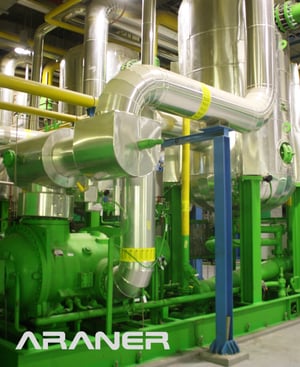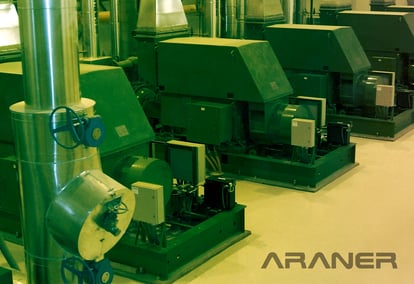Maintenance of large-scale industrial refrigeration units is arguably at the top of the list when it comes to the reliability, performance, and efficiency of the equipment. Preventative maintenance is essential to help avoid breakdowns and outages in the future and keeping your equipment working reliably for years to come; resulting in an overall increased return on investment. Regular checks of systems can help to locate problems and avoid further damage; small constraints in a system can also limit the efficiency of the overall system. These programs can also result in decreased labor costs and increased productivity across the long-term. Properly maintained chillers which function reliably tend to preserve the quality of the products as they are correctly stored, product quality is of utmost importance to the bottom-line of your business. Facilities should also consider the implementation of an energy management plan to sustain and improve upon the efficiencies realized through the maintenance program.
Best Practices
When we consider “Best Practices” for Industrial Refrigeration systems, there are four interrelated concepts that should all be considered to optimize overall system performance and assist in the making of sound business decisions. These are the design of the system, the operation of the system, maintenance as discussed here, and the commissioning of new construction and retrofits. Within each of these categories, we must consider the life-cycle costs of the equipment and energy-efficiency. When operating and maintaining a well-designed and constructed large-scale industrial refrigeration system and its components, there are several things to keep in mind. These “Best Practices” will help maintain a system that costs less to operate, maintains consistent temperatures, is accurate and reliable; even with varying production needs. First and foremost, you should always perform any maintenance prescribed by the manufacturer of your equipment, as the manufacturer maybe aware of items which need to be watched more closely on a particular unit. Tasks presented here may duplicate those prescribed by the manufacturer, and there may be suggestions here that you can use to create a facility maintenance list which incorporates both this list and the manufacturers specified maintenance. The use of such a plan may help not only with those aspects previously discussed but also with predicting the remaining life of the chiller, which can help with business plans and capital budgeting.
Daily Checks
There are several simple checks and tasks which you or your production staff can perform every day to ensure that your equipment is performing at its best. These include:

Industrial Chillers
- Keep the equipment clean, promptly clean any splatters, drips, or spills that occur; this helps prevent smells and mold growth, as well as remove a potential safety hazard.
- Verify the temperature and defrost settings, if applicable, of the unit at least once a day. The proper temperature setting avoids icing and excess energy use; if the defrost setting isn’t correct, the unit will work too hard.
- Inspect the unit’s seals and other areas which are prone to leaks; report or repair as required.
- Check to ensure that the lighting in the unit is shut off after use and at the end of the day to avoid unnecessary heat which will need to be overcome by the unit.
- Tracking equipment and system performance – Often, emerging problems can be identified and fixed before they significantly affect processes or energy performance. Maintaining detailed operating records and comparing performance data over time allows the identification of such problems promptly.
- Inspection for noises. Premature failure can be avoided with the vibration study of the machine. These vibrations are usually translated into audible noise, that can help the early detection of problems with the equipment.
- Check the drain pan and empty as necessary.
Periodic Maintenance Activities (Performed In-House or by a Professional)
- Clean heat exchangers – Approximately once a month, your system’s condenser and evaporator heat exchangers should be inspected and cleaned if required. When coils become caked with dirt and grime, it will interfere with the transfer of heat from your system and cause the system to work harder.
- Clean fan blades – Clean fan blades on a once per month schedule also. When fan blades are dirty, they will force the fan motors to work harder to rotate the blades. Check screws for tightness and inspect the general condition of the blades when cleaning.
- Defrost the unit as recommended by the manufacturer; doing so more often could result in the unit having to work harder. Working harder means increased energy consumption.
Maintenance Activities Should Always Be Performed by a Trained Professional
These activities require specialized knowledge and as such, should always be performed by an experienced professional. Furthermore, it is important to hire a professional with experience servicing your specific equipment; as each equipment can have specific peculiarities to watch for and only a technician with knowledge about the equipment will be aware of these. A maintenance plan will be specialized depending on your facility, the equipment, energy-efficiency goals, and more. These items should be among the first considered when developing a maintenance plan:
- Calibration – Calibration deals with ensuring that the controls are maintaining settings at targeted levels. Controls not properly calibrated can result in reduced energy efficiency. Poorly calibrated gauges, temperature sensors, and slide valves can lead to:
- Settings which are overly conservative to compensate for the unknown
- Misinterpretation or misdiagnosis of problems within the system
- Less effective overall performance of controls
- Evaporators
- Check and adjust valves
- Checks motors and controls
- Check fan blades
- Check instrument readings
- Check for gaskets in good condition with no water leakages
- Check that the drain line is free from obstructions
- Check the defrost heaters
- Tighten all electrical connections
- Compressors

- Compression in Industrial Refrigeration
- Check the operation of the controls
- Check compressor oil levels, test oil quality, and emulsification, replace as necessary
- Inspect all lines and hoses (refrigerant, capillary, and superheat)
- Inspect associated refrigerant valves
- Check for proper refrigerant levels
- Check the system superheat at the condensing unit
- Check all valve caps and unit covers, replace any which are missing
- Inspect and replace all filters and strainers
- Inspect and replace gaskets and mechanical seal
- Monitor vibrations and temperature
- Check alignment
- Perform a major overhaul
- Check electrical components
- Tighten electrical connections
- Condensers
- Ensure condenser fans operate properly, lubricated, screws are tight, and blades are in good condition
- Check fan settings
- Check for leaks
- Check heat exchangers for scale, descale as necessary, and confirm proper biocide concentration
- Clean the condenser water tubes according to manufacturer manual with a CIP (Clean-In-Place) in case of gasketed heat exchangers or open the condenser, clean and re-gasket.
- Confirm the use of appropriate seasonal settings to accommodate for changes in ambient air or available cooling water.
- Water pumps
- Inspection for leaks
- Monitor vibrations and temperature
- Re-greasing bearings
- Check alignment
- Replace gasket kit
- Replace mechanical seal
- Inspect impeller and shaft if required
The professionals at ARANER can help you create a maintenance program specifically for your facility and equipment to meet your goals. Let us help you achieve your goals for energy efficiency, product quality, and budget with a long-term maintenance plan for your industrial refrigeration unit.










